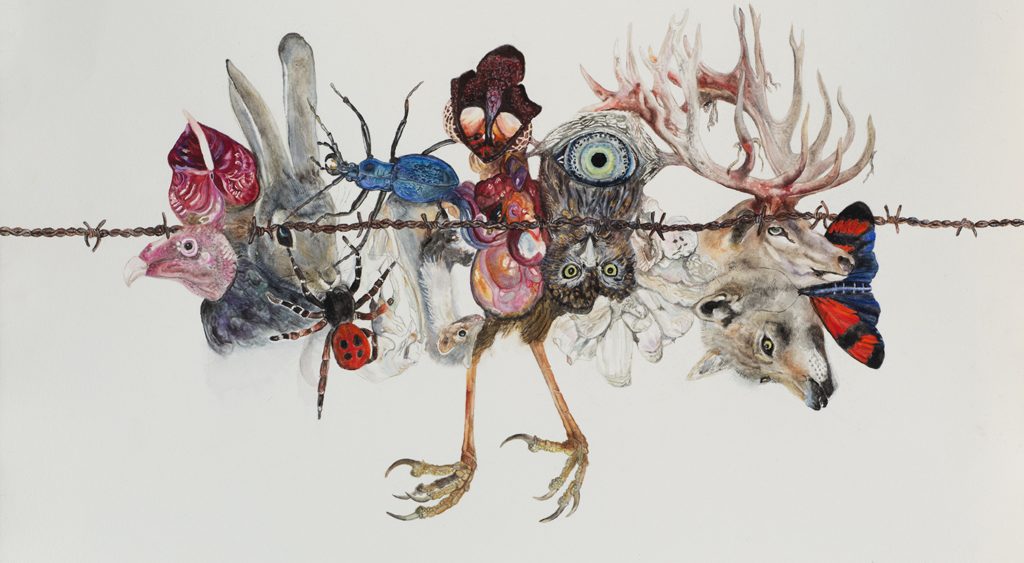Emilie Chaix uses classical materials and techniques to add ordinary organic shapes, forms and textures to foreground raw or biological forms – say, the deep red twist of a heart muscle, the wet line of an internal organ, the rounding asymmetry of a marine polyp – and including the discarded (literally, disregarded) parts of everyday shapes and forms – say, the stem of a rose, a chicken’s head, spider-web silk.
Essentially, Chaix’s work invites the onlooker to expand the range of what she enables herself to “see” in forms, images and textures. This “expansion by inclusion” is not meant to challenge convention but to enable us to appreciate a broader range of the world around us as “beautiful”. In this, Chaix’s approach is much bolder, but still analogous to, for example, Jorinde Voigt’s counter-intuitive presentation of strong pastels and affirmed line to “mathematize” – legitimize the visual esthetic of – “amorphous” forms.
Defining “gender” is mostly a story of visual esthetics, so it provides a good everyday example for what is going on in Chaix’s expansion of the visual esthetic through inclusion of what is “seeable” in form, imagery and texture. Conventional visual esthetic is generally founded on a notion of what is believed natural. Female sex organs, for example, are believed to be anatomicallyhidden while male organs are anatomicallyexposed, so that, in conventional visual esthetic, the female body is “not seeable” and the male body is “seeable”, so while Garter belts, thong underwear and painter’s brushes “reveal” what “nature has hidden” on women, “clothes make the man” and neck-to-toe clothing and dissimulating postures all hide what “nature” has not hidden to “show a man to advantage”. Female or male organs treated otherwise are “pornographic”, outside the canon of visual beauty.

So it is with gender representation, so it is with every other area of visual appreciation and the ways of representing them: lines/forms, colors, images, textures. A “broken line” is “broken”; there are “weak” and “strong” colors; “blood red” is “shocking”; a jelly fish is “unconventional”; a glistening heart muscle is “realistic”; and so forth. Contemporary visual artists most often use such technical and esthetic conventions as a point of departure in a search for a finer rendering of conventional beauty or to exploit the narrative possibilities raised (outside of the visual experience), in the same way as gender commentators use visual representation of female or male bodies to make a social or cultural point.

But Chaix – and as indicated above, she is not certainly not alone – is dealing with what may be appreciated rather that what is appreciated. She uses her technical ability, her subtle coloring, her fluid lines, her sense of setting – and conventional materials at her disposal to give the onlooker the time to realize that a rooster’s head (Cacoqphonie 3, 50 x 65, dessin, aquarelle, 2017) or a tick’s-body (Mauvaise posture, dessin, aquarelle, 36 x 48, 2017) is as sumptuous and visually touching as a flower. Chaix is not ironizing, (at least not here) she is not challenging, she is not pointing to narrative outside her painting. She is expanding and she’s including and she’s inviting the onlooker to join with her. When Chaix presents a field of cells and seeds it with conventional vegetalized forms and what appear to be brains (Zone de sensibilité, dessin, aquarelle, 36 x 48, 2016), or an exploded rhino head with a cellular structure in a shading of reds framed by grays (Qui nous sommes 1, dessin, aquarelle et encre, 24 x 36, 2016), or trophy heads, a bone, a butterfly, bird claws, spiders, an owl, an eye and a bunny-rabbit, presented in styles that recall the range between botanical-realistic and design-sketch, on a barbed-wire skewer (La Lisière, dessin, aquarelle, 78 x 57, 2017), she wants the onlooker to consider how all these styles, images and textures may be appreciated for themselves, how the onlooker may include them among “beautiful things”.
Go ahead and do it. The world looks a lot better when you have.
Tracy Danison

Sorry, the comment form is closed at this time.